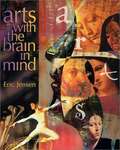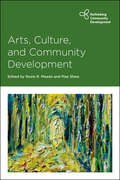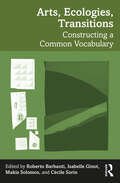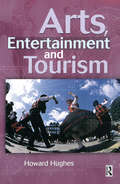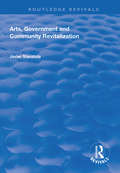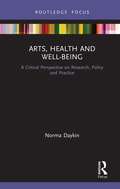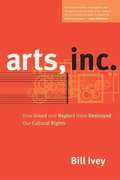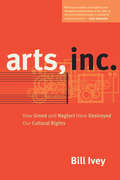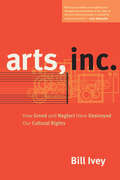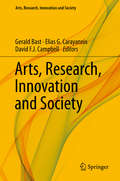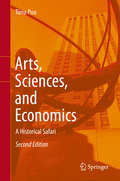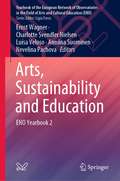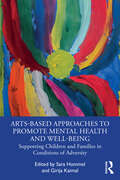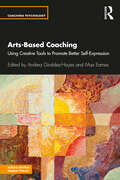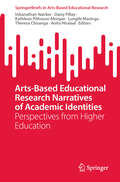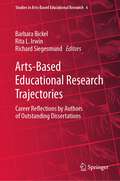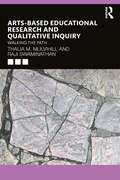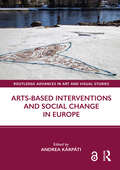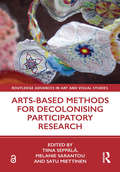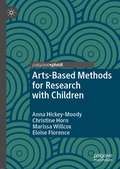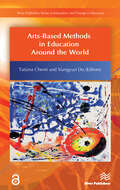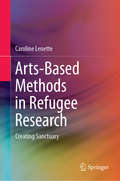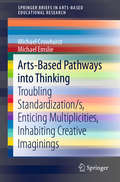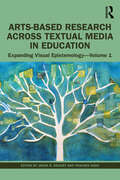- Table View
- List View
Arts with the Brain in Mind
by Eric JensenHow do the arts stack up as a major discipline? What is their effect on the brain, learning, and human development? How might schools best implement and assess an arts program? Eric Jensen answers these questions--and more--in this book. To push for higher standards of learning, many policymakers are eliminating arts programs. To Jensen, that's a mistake. This book presents the definitive case, based on what we know about the brain and learning, for making arts a core part of the basic curriculum and thoughtfully integrating them into every subject. Separate chapters address musical, visual, and kinesthetic arts in ways that reveal their influence on learning. What are the effects of a fully implemented arts program? The evidence points to the following: * Fewer dropouts* Higher attendance* Better team players * An increased love of learning* Greater student dignity* Enhanced creativity* A more prepared citizen for the workplace of tomorrow* Greater cultural awareness as a bonus To Jensen, it's not a matter of choosing, say, the musical arts over the kinesthetic. Rather, ask what kind of art makes sense for what purposes. How much time per day? At what ages? What kind of music? What kind of movement? Should the arts be required? How do we assess arts programs? In answering these real-world questions, Jensen provides dozens of practical, detailed suggestions for incorporating the arts into every classroom.
Arts, Culture and Community Development (Rethinking Community Development)
by Rosie R. Meade and Mae ShawHow and why are arts and cultural practices meaningful to communities? Highlighting examples from Lebanon, Latin America, China, Ireland, India, Sri Lanka and beyond, this exciting book explores the relationship between the arts, culture and community development. Academics and practitioners from six continents discuss how diverse communities understand, re-imagine or seek to change personal, cultural, social, economic or political conditions while using the arts as their means and spaces of engagement. Investigating the theory and practice of ‘cultural democracy’, this book explores a range of aesthetic forms including song, music, muralism, theatre, dance, and circus arts.
Arts, Culture, and Blindness: A Study of Blind Students in the Visual Arts
by Simon HayhoeThis book explores one of the most powerful myths in modern society: the myth that blind people are incapable of understanding and creating visual arts.
Arts, Ecologies, Transitions: Constructing a Common Vocabulary
by Makis Solomos Roberto Barbanti Isabelle Ginot Cécile SorinArts, Ecologies, Transitions provides in-depth insights into how aesthetic relations and current artistic practices are fundamentally ecological and intrinsically connected to the world. As art is created in a given historic temporality, it presents specific modalities of productive and sensory relations to the world. With contributions from 49 researchers, this book tracks evolutions in the arts that demonstrate an awareness of the environmental, economic, social, and political crises. It proposes interdisciplinary approaches to art that clarify the multiple relationships between art and ecology through an exploration of key concepts such as collapsonauts, degrowth, place, recycling, and walking art. All the artistic fields are addressed from the visual arts, theatre, dance, music and sound art, cinema, and photography – including those that are rarely represented in research such as digital creation or graphic design – to showcase the diversity of artistic practices in transition.Through original research this book presents ideas in an accessible format and will be of interest to students and researchers in the fields of environmental studies, ecology, geography, cultural studies, architecture, performance studies, visual arts, cinema, music, and literature studies.
Arts, Entertainment and Tourism
by Howard Hughes'Arts, Entertainment and Tourism' is a pioneering text that, by focusing on the consumer, investigates the relationship between these 3 industries and how this relationship can be developed to its best competitive advantage. Issue-led, this text draws on appropriate disciplines rather than using one single approach, to examine issues in arts and entertainment within the framework of cultural tourism.Written to meet the needs of students studying on management courses in the arts, tourism and leisure, 'Arts, Entertainment and Tourism':* Describes the general arts and tourism background* Identifies a framework for analysis that acknowledges differing levels of interest in the arts and entertainment* Discusses the arts and entertainment that feature (past and present) in tourism * Examines the reasons why the arts, entertainment and tourism have an interest in each other and how they go about developing the relationship* Examines the relationship: are there tourists in audiences and do the arts and entertainment attract tourists to a destination?* Evaluates the wider effects (good and bad) on both the arts and tourism* Discusses the direction of future developments by arts and tourism organizations and for future research
Arts, Government and Community Revitalization (Routledge Revivals)
by Javier StanziolaFirst published in 1999, this book goes beyond the standard economic tools used to evaluate the effectiveness of arts in redevelopment processes. It assumes that the sectors involved in the process of arts-led community revitalization (artists, non-profit organizations, government and for-profit firms) act upon the economic structure and initiate a resurgence path. This assumption allows us to study the political and economic interaction among these sectors, understand their incentives and define and explore their boundaries. This book explores the 1) cultural and regeneration reasons for revitalization; 2) sources of funds; 3) political interaction; 4) definition and estimation of output; 5) evaluation of output; 6) estimation of coefficients and multipliers effects obtained from input-output tables.
Arts, Health and Well-Being: A Critical Perspective on Research, Policy and Practice
by Norma DaykinThis important book develops a critical understanding of the bridging of arts and health domains, drawing on models and perspectives from social sciences to develop the case for arts and health as a social movement. This interdisciplinary perspective offers a new research agenda that can help to inform future developments and sustainability in arts, health and well-being. Daykin begins with an overview of the current evidence base and a review of current challenges for research, policy and practice. Later chapters explore the international field of health and the arts; arts, with well-being as a social movement; and boundary work and the role of boundary objects in the field. The book also includes sections summarising research findings and evidence in arts and health research and examples from specific research projects conducted by the author, chosen to highlight particularly widespread challenges across many arts, health and well-being contexts. Arts, Health and Well-Being: A Critical Perspective on Research, Policy and Practice is valuable reading for students in sociology, psychology, social work, nursing, psychiatry, creative and performing arts, public health and policymakers and practitioners in these fields.
Arts, Inc.: How Greed and Neglect Have Destroyed Our Cultural Rights
by Bill IveyIn this impassioned and persuasive book, Bill Ivey assesses the current state of the arts in America and finds cause for alarm. Even as he celebrates our ever-emerging culture and the way it enriches our lives here at home while spreading the dream of democracy around the world, he points to a looming crisis.
Arts, Inc.: How Greed and Neglect Have Destroyed Our Cultural Rights
by Bill IveyIn this impassioned and persuasive book, Bill Ivey, the former chairman of the National Endowment for the Arts, assesses the current state of the arts in America and finds cause for alarm. Even as he celebrates our ever-emerging culture and the way it enriches our lives here at home while spreading the dream of democracy around the world, he points to a looming crisis. The expanding footprint of copyright, an unconstrained arts industry marketplace, and a government unwilling to engage culture as a serious arena for public policy have come together to undermine art, artistry, and cultural heritage--the expressive life of America. In eight succinct chapters, Ivey blends personal and professional memoir, policy analysis, and deeply held convictions to explore and define a coordinated vision for art, culture, and expression in American life.
Arts, Inc.: How Greed and Neglect Have Destroyed Our Cultural Rights
by Bill IveyIn this impassioned and persuasive book, Bill Ivey, the former chairman of the National Endowment for the Arts, assesses the current state of the arts in America and finds cause for alarm. Even as he celebrates our ever-emerging culture and the way it enriches our lives here at home while spreading the dream of democracy around the world, he points to a looming crisis. The expanding footprint of copyright, an unconstrained arts industry marketplace, and a government unwilling to engage culture as a serious arena for public policy have come together to undermine art, artistry, and cultural heritage—the expressive life of America. In eight succinct chapters, Ivey blends personal and professional memoir, policy analysis, and deeply held convictions to explore and define a coordinated vision for art, culture, and expression in American life.
Arts, Research, Innovation and Society (Arts, Research, Innovation and Society)
by Elias G. Carayannis David F. J. Campbell Gerald BastThis book explores - at the macro, meso and micro levels and in terms of qualitative as well as quantitative studies - theories, policies and practices about the contributions of artistic research and innovations towards defining new forms of knowledge, knowledge production, as well as knowledge diffusion, absorption and use. Artistic research, artistic innovations and arts-based innovations have been major transformers, as well as disruptors, of the ways in which societies, economies, and political systems perform. Ramifications here refer to the epistemic socio-economic, socio-political and socio-technical base and aesthetic considerations on the one hand, as well as to strategies, policies, and practices on the other, including sustainable enterprise excellence, considerations in the context of knowledge economies, societies and democracies. Creativity in general, and the arts in particular, are increasingly recognized as drivers of cultural, economic, political, social, and scientific innovation and development. This book examines how one could derive and develop insights in these areas from the four vantage points of Arts, Research, Innovation and Society. Among the principal questions that are examined include: - Could and should artists be researchers? - How are the systems of the Arts and Sciences connected and/or disconnected? - What is the impact of the arts in societal development? - How are the Arts interrelated with the mechanisms of generating social, scientific and economic innovation? As the inaugural book in the Arts, Research, Innovation and Society series, this book uses a thematically wide spectrum that serves as a general frame of reference for the entire series of books to come.
Arts, Sciences, and Economics: A Historical Safari
by Tönu PuuThis book deals with the economic aspects of changing attitudes in arts and sciences. The effects of the public good character of culture, along with the very long production period and lifetime for its products, are emphasized, since both contribute to the failure of normal market solutions. Embodiment of ideas and the consequences of modern reproduction technology for protection of property rights are closely examined. The evolution within arts and sciences, which often seems to return to previously scrapped ideals, is illustrated by detailed case studies, in which the importance of changing tastes, rather than progress proper, is emphasized. The author attempts an understanding for this using Darwinian evolution in combination with modern mathematical complexity theory, expressed in terms accessible to the general reader. The second edition is extended and updated especially as regards the illustration material.
Arts, Sustainability and Education: ENO Yearbook 2 (Yearbook of the European Network of Observatories in the Field of Arts and Cultural Education (ENO))
by Luísa Veloso Charlotte Svendler Nielsen Ernst Wagner Anniina Suominen Nevelina PachovaThis book explores the potential of arts and cultural education to contribute to on-going efforts to promote Education for Sustainable Development (ESD) in line with UNESCO’s conceptualizations of the field. It builds on the experiences of arts educators working to build sustainable futures and portrays new and innovative approaches. Chapters comprise case studies that combine arts, culture, sustainable thinking and practices. They also include research from historical perspectives, evaluations of public policy measures and offer theoretical approaches and methodologies. The book unfolds the possible relationships between arts and cultural education and Education for Sustainable Development.
Arts-Based Approaches to Promote Mental Health and Well-Being: Supporting Children and Families in Conditions of Adversity
by Girija Kaimal Sara HommelThis book provides insights on how creative and expressive approaches can promote psychosocial well-being among children, youth, and their caregivers living in conditions of adversity around the world.Arts-based psychosocial approaches give children a means to tap into their strengths as well as adaptively communicate and process experiences in ways that promote their own and overall family well-being. Offering an overview of the impact of adverse childhood experiences on lifelong health and functioning and how arts-based approaches can be protective, this book discusses relevant theory and research, as well as case studies and findings from mixed methods program evaluations. Examples from the Healing and Education Through the Arts (HEART) initiative from Save the Children are discussed in depth, and demonstrate the benefits of creative self-expression among children and families in the most challenging environments around the world.Creative arts therapists, public health professionals, education specialists, policymakers, and humanitarian groups seeking to provide cost-effective support to communities in need will find, in this book, insights on the impact of large-scale arts-based interventions in a range of public health and education settings.
Arts-Based Coaching: Using Creative Tools to Promote Better Self-Expression (Coaching Psychology)
by Andrea Giraldez-Hayes Max EamesThis book, written in an accessible way by leading experts in the field, offers a comprehensive exploration of arts integration in coaching through the lenses of positive and health psychology.Drawing together international experts and interdisciplinary perspectives, including health and neuroscience, the book explores the intersection of positive psychology and the arts, offering insights and strategies for using art to promote personal growth. The chapters in this book weave theory into practice, condense research and theoretical concepts into straightforward frameworks, and offer easily understandable ideas and examples. It provides a theoretical rationale for various art forms, including poetry, music, visual arts, dance, cinema, and photography. Each chapter includes case studies to present practical ways in which arts can enhance coaching conversations.Arts-Based Coaching is a practical guide that will interest coaching psychologists, coaches, dual practitioners offering therapeutic coaching, leaders, educators, and other professionals using coaching in their professional practice, as well as course leaders and students in coaching and coaching psychology.
Arts-Based Educational Research Narratives of Academic Identities: Perspectives from Higher Education (SpringerBriefs in Arts-Based Educational Research)
by Kathleen Pithouse-Morgan Daisy Pillay Inbanathan Naicker Lungile Masinga Theresa Chisanga Anita HiralaalThis book delves into the complexities of being and becoming an academic in higher education. Inspired by the arts, the book introduces new voices and insights to scholarly discussions about what constitutes data and analysis in higher education research. It demonstrates ABER’s ability to shape and critique academic identity narratives in response to pressing problems and dilemmas in higher education. The book includes exemplars from studies conducted primarily in South African contexts and led by South African researchers. It explores diverse modes, including collage, digital artwork, letter writing, metaphor, creative nonfiction, and theatre-making. Contributions from expert scholars in Canada and the USA supplement this research and show how it has been enriched by critical transcontinental conversations. The authors offer new perspectives on the entwined and complex relationship between the ABER, narratives, and identities.
Arts-Based Educational Research Trajectories: Career Reflections by Authors of Outstanding Dissertations (Studies in Arts-Based Educational Research #6)
by Rita L. Irwin Richard Siegesmund Barbara BickelThis book offers reflections from Arts-Based Educational Research (ABER) scholars who, since 2005, were awarded the American Educational Research Association ABER Special Interest Group's Outstanding Dissertation Award. The book includes essays from ten awardees who, across diverse artistic disciplines, share how their ABER careers evolve and succeed—inspiring insights into the possibilities of ABER. It also examines the essential role of mentorship in the academy that supports and expands ABER scholarship. Drawing from dissertation exemplars in the field, this book allows readers to look at how ABER scholars learn with the world while creatively researching and teaching in innovative ways
Arts-Based Educational Research and Qualitative Inquiry: Walking the Path
by Raji Swaminathan Thalia M. MulvihillArts-Based Educational Research and Qualitative Inquiry introduces novice qualitative researchers, within education and related fields, to arts-based educational research (ABER). Abundant prompts and exercises are provided to help readers apply the concepts and experiment with various applications of the ideas presented. The authors walk the path with novice researchers offering a variety of approaches to the practice of arts-based methods, while providing a guided overview of ABER, and include pedagogical features in each chapter. Exercises are designed to assist educational researchers who wish to expand their repertoire of methodologies. The authors also weave into the discussion the possibilities and limitations of many types of arts-based methods while introducing readers to the growing methodological literature. By offering a tapestry of ways to engage the novice researcher, the book illustrates that it is not always possible to separate cognitive findings from aesthetic knowing. This book will help qualitative researchers to expand their methodologies to include arts-based approaches to their projects and by doing so reshape their identities as qualitative researchers. It also offers some evaluative criteria and tool kits for experimenting with various arts and educational research.
Arts-Based Interventions and Social Change in Europe (Routledge Advances in Art and Visual Studies)
by Andrea KárpátiThis book presents 23 successful arts-based efforts to respond to social problems experienced by disadvantaged communities. The arts are a powerful means of fighting discrimination, marginalisation, neglect and even poverty. The educational programmes described in these chapters help stakeholders find solutions which are research-based, adaptable, repeatable and sustainable. Social problems that are addressed in this book include children living with physical challenges; suffering from financial and educational poverty; elderly women suffering from solitude; migrants facing a strange and not always welcoming cultural context; Roma youth fighting negative stereotypes and many more. Revealing the interconnectedness between social, economic and cultural exclusion, contributors planned interventions to develop skills, strengthen identities and build communities. This book will be of interest to scholars working in the visual arts, art education, design education, drama and theatre education and museum pedagogy. The Open Access version of this book, available at http://www.taylorfrancis.com, has been made available under a Creative Commons [Attribution-Non Commercial-No Derivatives (CC-BY-NC-ND)] 4.0 license.
Arts-Based Methods for Decolonising Participatory Research (Routledge Advances in Art and Visual Studies)
by Tiina Seppälä; Melanie Sarantou; Satu MiettinenIn an effort to challenge the ways in which colonial power relations and Eurocentric knowledges are reproduced in participatory research, this book explores whether and how it is possible to use arts-based methods for creating more horizontal and democratic research practices. In discussing both the transformative potential and limitations of arts-based methods, the book asks: What can arts-based methods contribute to decolonising participatory research and its processes and practices? The book takes part in ongoing debates related to the need to decolonise research, and investigates practical contributions of arts-based methods in the practice-led research domain. Further, it discusses the role of artistic research in depth, locating it in a decolonising context. The book will be of interest to scholars working in art history, design, fine arts, service design, social sciences and development studies.
Arts-Based Methods for Research with Children (Studies in Childhood and Youth)
by Anna Hickey-Moody Christine Horn Marissa Willcox Eloise FlorenceThis book offers a practical, methodological guide to conducting arts-based research with children by drawing on five years of the authors’ experience carrying out arts-based research with children in Australia and the UK. Based on the Australian Research Council-funded Interfaith Childhoods project, the authors describe methods of engaging communities and making data with children that foreground children’s experiences and worldviews through making, being with, and viewing art. Framing these methods of doing, seeing, being, and believing through art as modes of understanding children’s strategies for negotiating personal identities and values, this book explores the value of arts-based research as a means of obtaining complex information about children’s life worlds that can be difficult to express verbally.
Arts-Based Methods in Education Around the World: Higher Education Around The World (River Publishers Series In Innovation And Change In Education Ser.)
by Tatiana Chemi Xiangyun DuArts-Based Methods in Education Around the World aims to investigate arts-based encounters in educational settings in response to a global need for studies that connect the cultural, inter-cultural, cross-cultural, and global elements of arts-based methods in education. In this extraordinary collection, contributions are collected from experts all over the world and involve a multiplicity of arts genres and traditions. These contributions bring together diverse cultural and educational perspectives and include a large variety of artistic genres and research methodologies.The topics covered in the book range from policies to pedagogies, from social impact to philosophical conceptualisations. They are informative on specific topics, but also offer a clear monitoring of the ways in which the general attention to the arts in education evolves through time.
Arts-Based Methods in Refugee Research: Creating Sanctuary
by Caroline LenetteDrawn from a decade of refugee studies, this book offers a wealth of insights on arts-based methodologies. It explores exciting new prospects for participatory and culturally safe research, and will be a reference resource for researchers of all levels and community practitioners.The book tackles questions of meaningful research practice: How do people with lived experiences of forced migration—Knowledge Holders—lead the way? Can arts-based methods bring about policy and social change? And what of ethical issues?By reflecting on the strengths and limitations of four research methods (digital storytelling, photography, community music, and participatory video), readers are invited to craft their own approach to arts-based projects.
Arts-Based Pathways into Thinking: Troubling Standardization/s, Enticing Multiplicities, Inhabiting Creative Imaginings (SpringerBriefs in Arts-Based Educational Research)
by Michael Crowhurst Michael EmslieThis book, based on a critical/collective/auto/ethnographic research project, describes an assemblage of theoretically informed, arts-based methods that aim to promote multiplicity and thinking. It explores multiplicities of knowing, sensing, doing and being, generated by analyzing knowing frames, poetry, reading aloud, fableing, playwriting and other inventive, playful and scholarly ways of working with experiences and stories. By offering engaging and inspiring strategies that can disturb standardizations and interrupt cultural normativities, the book sheds light on the conditions that might be present in cultural contexts that enable diversity and creativity. The research project on which this book is based originated from a contradictory set of conditions characterized on the one hand by a marked interest in creative research methods and novel knowledge practices and, on the other hand, by a widespread concern that we live in increasingly standardized times, featuring systems that specify objectives ahead of time, demand compliance and narrow the possibilities for human action. The book takes readers on an arts-based journey designed to enhance the opportunities for imaginative and ethical professional practice in education, human services and the arts.
Arts-Based Research Across Textual Media in Education: Expanding Visual Epistemology - Volume 1
by Jason D. DeHart Peaches HashIn company with its sister volume, Arts-Based Research Across Textual Media in Education explores arts-based approaches to research across media, including film and comics-related material, from a variety of geographic locations and across a range of subdisciplines within the field of education. This first volume takes a textual focus, capturing process, poetic, and dramaturgical approaches. The authors aim to highlight some of the approaches that are not always centered in arts-based research. The contributors represent a variety of arts-based practices and methods, and they weave this marrying of artistic and scientific expertise and experience into the fabric of the chapters themselves. Authors from international contexts speak to the importance of utilizing artistic approaches for research processes. From multimodal field notes to poetic forms to the dramaturgical, chapters in this book represent steps forward in educational inquiry to bringing together both the creative and credible. The book includes multiple images and rich descriptions shared from the field. This first volume covers amongst other topics: co-created narratives, creative fiction in research, analytic portraits, dramatic representation, and critical poetic inquiry. It would be suitable for graduate students and scholars interested in qualitative inquiry and arts-based methods, in education and the social sciences.
